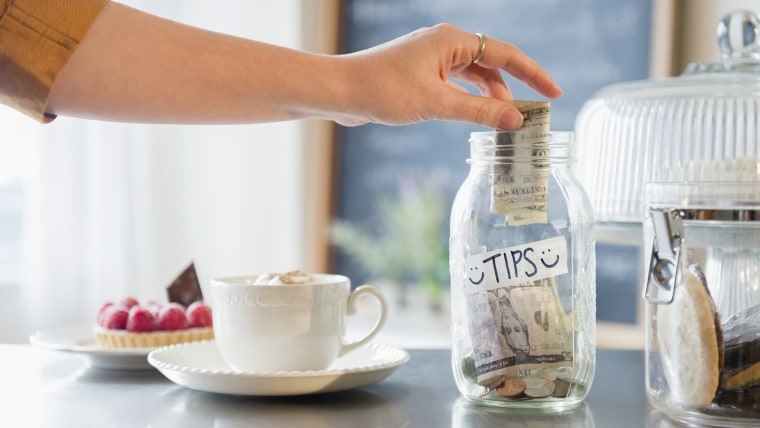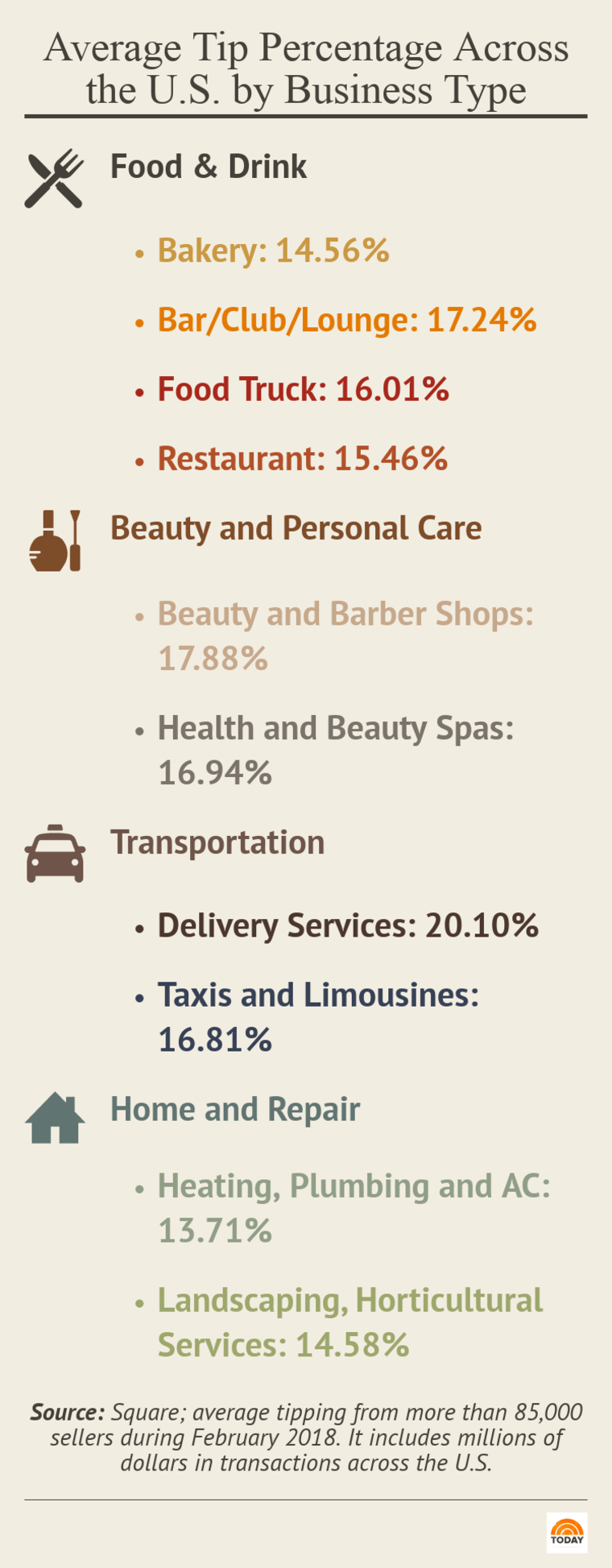In an increasingly cashless society, electronic tips at eateries and retail shops are replacing the old-fashioned tip jars that frequently sat next to cash registers.
But after swiping your credit or debit card, do you agree to a 10, 15 or 20 percent tip for something you have yet to receive — or do you hit the “no tip” button and brace yourself for inferior service from an insulted cashier?

It’s a dilemma faced by a growing number of credit card users who hand over plastic to the cashier behind the counter at the bagel shop in the morning. Or the food truck at lunch. Or perhaps the bubble tea kiosk for that mid-afternoon break.
Guilt Tipping?
Today, it’s nearly impossible to avoid deciding whether to add an extra dollar or two onto a bill for products or in businesses people never previously associated with gratuities.
“I don’t call it a guilt trip, but a guilt tip,” said Thomas Farley, an etiquette expert and modern manners coach.
“With that big ‘no tip’ button staring us in the face, and you know two seconds later that screen is going to be spun back around to the person who just waited on you, suddenly we feel we’re being cheap if we don’t give any kind of a tip.”
Popular electronic tablet-based payment systems, including ShopKeep, Square and Revel, can make tipping almost effortless. The decision to include a “tipping prompt” rests solely on the merchants.
ShopKeep, one of the industry’s leading cloud-based point-of-sale providers, says about 23 percent of its merchants have enabled a tip screen for their businesses. Among its “quick serve” clients, like cafés and bakeries, about 49 percent have the tip options turned on. But even 12 percent of its more traditional retailers — which include everything from clothing boutiques, flower shops and liquor stores to beauty salons and barber shops — have enabled that functionality.
With that ease also comes confusion: Some sort of tip is a given when visiting shops that include any type of table service, but what about fast-casual businesses like coffee shops, delicatessens or food trucks?
Farley said it depends. Customers shouldn’t feel obligated to tip at grab-and-go places that are nearly all or entirely self-service. It's also OK to forgo the tip at most fast-casual places like bakeries or ice cream shops that pay their workers at least a minimum wage.
But, if you’re a regular at such a business, or happen to have placed a large, complex order to bring back to the office, consider throwing in a tip.
Cashless Customers
At Loving Cup, a group of made-to-order frozen yogurt shops throughout the San Francisco area, customers can choose to drop their change inside an old-fashioned tip jar or add a gratuity with a credit card. But with about 4 out of 5 customers using credit cards to pay, most of the tips come electronically, said Liz Fiedler, the business’s owner.
"We saw a huge increase (in tips) when we started using Square and having that screen on. I’d say at least 30 percent,” she said. “A lot of times, people don’t have cash on them, so they might not have an extra dollar or two to throw in the tip jar but they’re happy to give it to you on the credit card. They’re like, ‘I want to tip, I just don’t have the cash.’”
Most people pay a percentage of the total since their total sales ticket average is about $7.50, Fielder said. The average tip is about $1 to $1.50.
Sadiya Nez, a manager at New York café Gotan, said it’s OK to hit the “no tip” button — and yes, she does see when it gets tapped.
“It’s not a big deal at all,” she said.
Nez said that when she flips over her payment screen for a signature, customers are usually focused on simply finishing the transaction.
“Half the time they’ll be like, ‘What is this? What am I looking at?' because they just want to see a line, and they don’t see the line,” said Nez, 26.
When to Reject Tipping
Historically, tipping originated in the 17th century as an incentive “to insure promptness” among servers inside English coffee houses, said Peggy Newfield, founder and president of the American School of Protocol.
A customer should always feel the right to reject tipping, especially if the person who would receive it hasn’t earned one, she said.
“Attitude is king. If someone is not anxious to serve me, got the order wrong because they weren’t paying attention, then I’m very comfortable leaving no tip,” Newfield said. “As long as the money is coming out of my pocket, then I am in charge and I feel no guilt whatsoever.”
If you do want to tip, how much is appropriate?

Newfield’s standard is 10 percent if she is paying for food or service she has yet to receive — but only if the cashier or server has earned the tip.
“If it’s a happy day, meaning all smiles and they’re there to serve me? OK, fine. I’m going to tip and no more than 10 percent,” she said.
Greasing the Wheels
Shopkeep, Square and other companies give their merchants several options when it comes to tipping. They can set it as a percentage of the total sale, or in specific, fixed amounts.
Gotan, the New York café, offers customers a chance to do both.
For anything under $10, they can add another buck or two to the bill. Most of the time, they’ll add a dollar, Nez said.
Anything above $10, customers can add a tip based on the percentage of the total bill. Nez said the business experimented with amounts — from 10 to 18 percent, then from 15 to 20 percent — and settled on the lower range because it encouraged more people to tip.
When people were given the option of tipping 10, 15 or 18 percent, customers usually opted to tip 10 percent. But when they were presented with a range from 15 to 20 percent, customers chose the “no tip” option.
According to Square data compiled in February among its merchants, the average tip across all business types was 16-17 percent. The average for bakeries and food trucks was about 15 percent.
'A Charity Thing'
Fiedler, the 38-year-old frozen yogurt shop owner, said she believes most people who tip take into account what a job entails, especially one in the service industry.
“You know it’s hard work. We also know that these people are getting paid minimum wage,” she said. “It’s almost more of a charity thing — like, I get the work you’re doing. I appreciate the work you’re doing, and I know you’re not getting paid a lot, so I’m going to help you out.”
But all customers should feel comfortable with whatever decision they choose when it comes to tipping, including not providing one at all.
“That screen gives you the option to say, ‘no tip.’ You still have the choice,” she said.
Fiedler points out that her customers also have the option of closing out the screen after providing their signature, but before turning it back to the cashier, by pushing a button at the bottom of the screen. On other systems, that same option comes from tapping a small circle with an “x” inside.
“Even if you gave a $5 tip, sometimes you still want to be discreet,” she said.
A new device by ShopKeep seems to indicate people tend to be more generous if they can keep their tipping decisions private.
The company’s basic point-of-sale system runs on a tablet that flips from cashier to customer at the end of a credit card transaction. But the new device, one separate from the tablet and which faces the customer at all times, has generated interesting tipping behavior, according to initial company data.
“We’ve actually seen an increase in tip volume if it’s only facing the consumer and not facing the person behind the counter, which I thought was counterintuitive,” said ShopKeep CEO Michael DeSimone. “Apparently people feel more comfortable tipping if they think the person behind the counter can’t see them.”
TODAY writers Danielle Wolf and Iggy Monda contributed to this story.